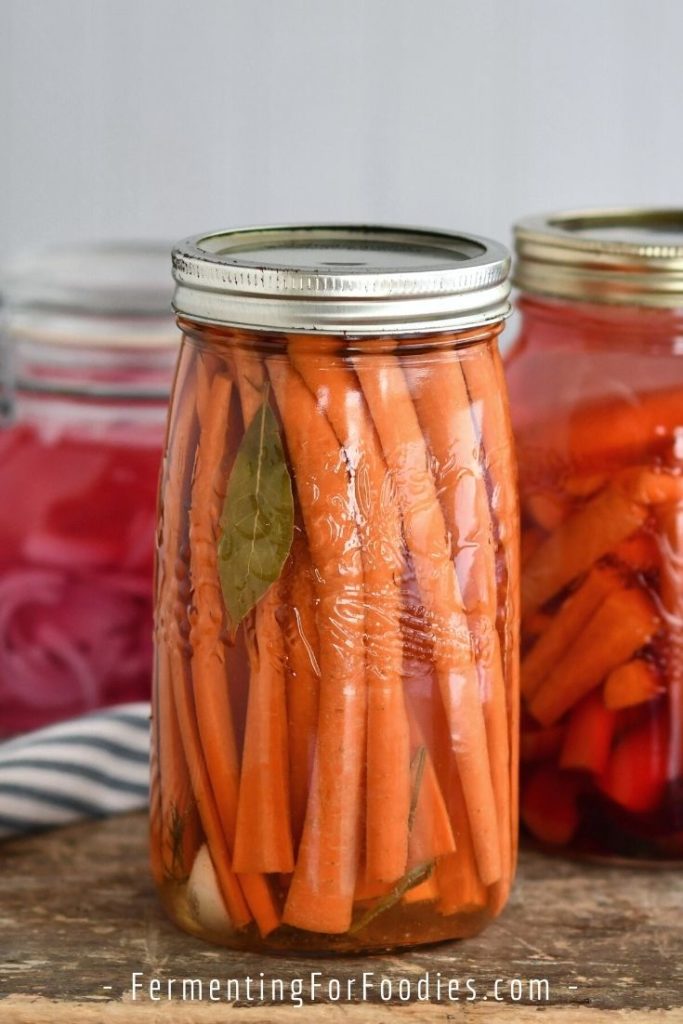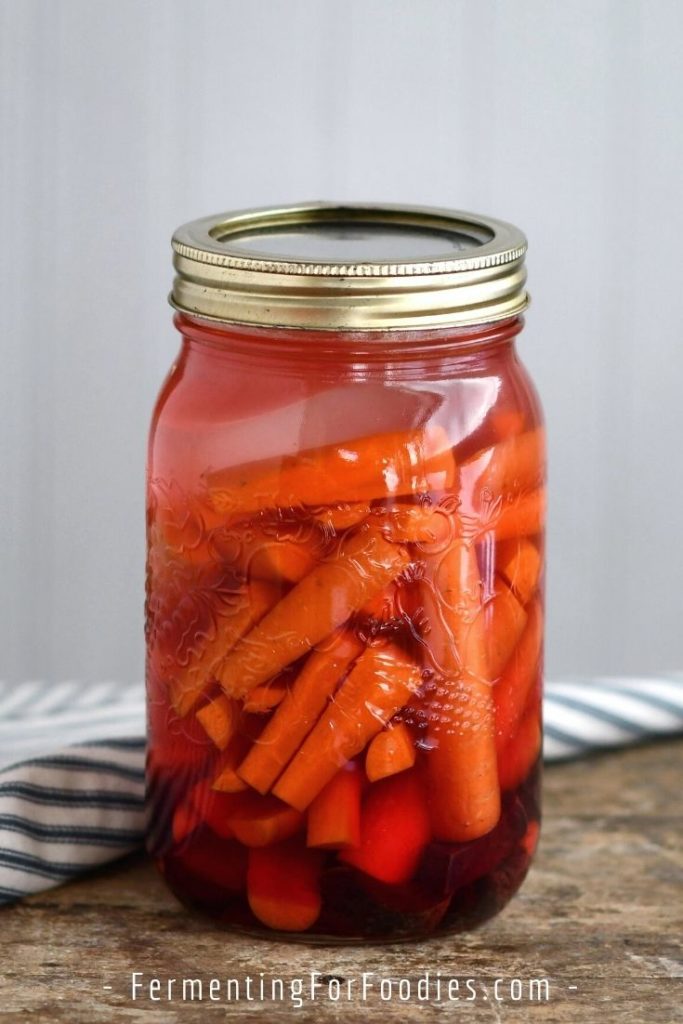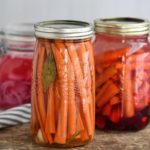Fermented carrot sticks are one of my family’s favorite snacks. During the school year, we always have a few jars of pickled carrots in the kitchen. They are quick to make. Easy to serve. And deliciously flavorful.

Why I love fermented carrot sticks
Honestly, fermented carrot sticks are my go-to winter snack. We don’t usually bother in the summer when we’re able to buy fresh, sweet carrots from the farmers’ market. However, fermenting is the best way to eat the bitter, winter storage carrots.
Here are a few reasons why we love fermented carrot sticks:
- They are so quick to make. Honestly, it’s as easy as chopping up carrots for a snack.
- The brine can be reused a number of times, making it even easier to ferment carrots.
- They are a great way to get probiotics into my kids.
- Fermenting carrots helps to release the beta-carotene, making them more nutritious than raw carrots.
- Fermented carrots are softer than typical carrot sticks, so they are easier for toddlers and young children to eat.
Flavoring Fermented Carrots
The best part about making fermented carrot sticks is that they are perfect for all sorts of different flavors!
Here are a few options:
- Dill pickle: add 1 clove of garlic 1 tsp of pickling spice and a sprig of dill to each jar.
- Curry: 2 tsp of Indian curry spice mix.
- Sweet beet: make a mix of sliced beets and carrots for a sweet mix.
- Spicy: add 1 jalapeno pepper sliced in half along with a few slices of onion.
- Caraway mustard: 1 tsp of mustard seed and 1 tsp of caraway.
- Bay: my favorite flavor is 1 leaf of bay with 1 clove of garlic.

How to Reuse Brine
Carrots don’t need to be packed into new brine every time. That’s what makes them so easy! As long as the brine is yeast and mold-free, you can add in more carrot sticks for another round of fermentation.
Here are a few details:
- The ferment will go quite quickly the second time around. Only leave the carrot sticks out of the fridge for up to 2 days.
- If the brine has stuff floating in it (usually bits of herbs and spice) then pack the carrots into it and store it in the fridge instead. The risk of contamination is greater if there’s anything that floats on the surface of the ferment.
- It will take carrots between 3 to 7 days to ferment in the fridge. Cooler temperatures slow down fermentation, however, it doesn’t stop it completely.
- I usually reuse brines 3 to 5 times. You could probably do more than that, but I have so many ferments in my fridge that I like to cycle through the flavors.
- When I’m done with my brine I use it in place of stock for soups and stews. It’s quite salty, so expect to reduce the amount of salt in your soup.
Packing into brine from Other Ferments
One of the simplest ways to make fermented carrots is to pack them into brine leftover from a different ferment! Then the carrots will naturally take on the flavor of that ferment.
Here are a few options:
- Fermented onions
- Brined kimchi
- Fermented dill pickles
- Italian pickled vegetables
- Sweet and spicy pickles
It’s fine to mix and match brines. Or to use brines from sweet ferments. Feel free to experiment with this very versatile vegetable!
Fermented Carrot Sticks
I love fermented carrot sticks because they are a quick, easy, and delicious snack. The perfect use for those bitter winter storage carrots. The brine can be reused to make several batches, making it even easier to enjoy probiotic carrot sticks. See the section above for details on flavoring carrot sticks and reusing the brine.
- Prep Time: 8 minutes
- Total Time: 8 minutes
- Yield: 1 quart jar 1x
- Category: Pickles
- Method: Fermented
- Cuisine: Probiotic
- Diet: Vegan
Ingredients
- 2 cups of water (chlorine-free, enough to cover)
- 3 tsp non-iodized salt
- 4 to 6 large carrots
- Flavors (see section above)
Instructions
- Mix the salt and 1 cup of water in a quart-sized jar to make a brine.
- Wash and cut the carrots into sticks. It’s not necessary to peel them, however, feel free if the skin is particularly rough.
- Add flavors to the jar, first, to keep them from floating. Then pack in carrots making sure that the carrots are 1-inch (2.5 cm) below the top. Try to pack the carrots in tightly, or use a weight to keep them from floating above the brine.
- Add enough water to completely submerge the carrots. Be sure to leave a bit of head room for bubbling. Be sure to use a jar that will allow gas to escape during the ferment. See notes for details.
- Place the carrots in a dark, room-temperature location (a kitchen cupboard is perfect). Let them ferment for 3 to 7 days. After three days the carrots will be deliciously fermented, but still crisp. They will continue to soften the longer they ferment.
- Store in the refrigerator and enjoy within 1 month.
Notes
- Organic, field-grown carrots can ferment without a starter. However, starters are a great way to boost the ferment and add flavor. Starter options include sour kombucha, sauerkraut juice, cultured apple cider vinegar, or a purchased starter. Use 2 Tbsp of culture per quart jar.
- I usually use a wide-mouth mason jar
with a loosely tightened lid for my carrot sticks. But it’s fine to use a specialized fermentation jar, especially if you have issues with mold in your house.



Do you peel the carrots?
Nope, the skin helps provide some of the culture for the ferment. Enjoy!
First time doing this. May be my last. Lol.
Purchased starter packets call for salt to be added to the water to make a brine with the packets. Do you make the brine the way it says and then add more salt (the 2 tsp of salt in your recipe) in the jar? Thanks for the help.
Follow the instructions on the package for the salt, since it should be a proper brine ratio. Don’t add any extra salt or it will end up too salty. Enjoy!
Do you need to boil the water?
The water needs to be at room temperature for fermentation. However, if there is something wrong with your water (like lots of chlorine, or unsafe for drinking) then you can boil your water. Just let it cool before you make your fermented carrots. Cheers!
That looks amazing, definitely making this.
What do you mean with culture?
Is there a special starter for fermenting food?
I make water kefir, can I use that as a started
You absolutely don’t need to add a fermented culture. However, it can be a fun way to change the flavor of the ferment. Culture includes any fermented and probiotic liquid. So homemade water kefir is perfect!
I’d like to try the sweet beet version… so u not out anything else in the way of spices in the jar except the salty water.?
Generally when I make a beet and carrot ferment, I don’t add flavor. But you could add whatever spices you might enjoy. Cloves are sweet, but garlic also nice. Enjoy!
Mine turned out well with a couple of differences. I *always* boil the water and salt, then let cool to room temperature. This can easily be done in the morning, and then finish the process in the afternoon. In the winter, I find I have to let the brine sit for longer than 7 days. I keep a careful watch on top liquid level. I taste intermittently and refrigerate when it is the texture I like. One of the additions I enjoy is raw garlic. Great recipe!
Thanks for sharing!
^^^ Additional note to my above comment. I use organic carrots, and I do not peel them. Remove the tip and end of carrots. Scrub them thoroughly with a fine-bristle brush and rinse in cool water. The natural, healthy microbes in the skin are beneficial to the ferment, 🙂
Having a great time looking at your site.
Just about to try the carrot recipe. Sounds luscious.
Am new to fermenting, so can you tell me: the Fido jars you mention look to me as if they are either tightly closed, or open. I can’t see how you can close them loosely? Am I being dumb?
Your book looks great. Present for self and daughter, perhaps.
Hi Roselle,
High-quality fido jars have a gasket type of seal that allows gas to escape but prevents contamination. I always offer a few options for fermenting. If you’re using a regular jar, just use a loosely tightened lid. If you have a fido jar, feel free to seal it! Just be cautious of decorative fido jars which may not be able to handle the build-up of pressure during fermentation. Cheers, Emillie
Hi Emillie
Thank you. OK, so any jar, like a Kilner jar, with a rubber gasket is OK to close tight? And do the split-type lids work in this way too?
Best
Roselle
Not exactly. You can only close jars that are made for the pressure of fermentation (like brand name fido jars). I’m not sure a kilner canning jar is ok to ferment in. I think they have a different top with an airlock for fermenting. And regular mason jars are not strong enough for fermenting. I use those a lot… but I just don’t tighten the lid all the way. That allows the gas to bubble out. It works pretty well for me!
Can salt WITH iodine be used? You specified non-iodine, so is that a preference or need for this recipe? Thanks!
Iodized salt often has other additives (anti-clumping agents) that may affect fermentation. Also, iodine is thought to slow fermentation, however, it’s unlikely to have a huge effect. If you only have regular, iodized salt then it should be fine. Cheers!
If I reuse a brine do I need to add more salted water to bring the level over the top of the veggies?
You don’t have to make extra brine when reusing brine… however, if you don’t have enough brine to cover your veggies, then you will definitely need to mix up a bit more. It’s important to keep everything submerged below the brine. I usually don’t make extra brine. I just pack a jar until it’s full, but not over full. Cheers!
Once the carrots have fermented the proper amount of time, and are ready to transfer into refrigerator, do the carrots still need to always remain totally under the liquid? Also, do the lids still need to be loose, or can they be tightened? I’m new to fermenting. My first batch is prepared (today) in mason jars, currently with loose lids, and are in the dark.
Hi Bobbie, Congrats on your first ferment! Once you’re ready to start eating the carrots, remove the weight, and store them in the fridge with a tightened lid. The fermentation will mostly stop at that point. It’s best if the carrots remain in the brine, or they’ll start to go brown. If you made tall sticks you may need to add a bit more water as you eat them. Shorter sticks shouldn’t have an issue. When topping up the brine, you can either use just water, which will reduce the saltiness, or use a mix of water and salt. About 1 cup of water needs 1 tsp of salt. Enjoy!